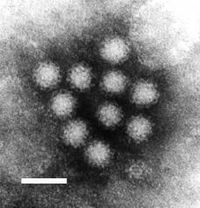
Photo from wikipedia
Norovirus infections are a leading cause of acute gastroenteritis worldwide, affecting people of all ages. There are 10 norovirus genogroups (GI-GX) that infect humans and animals in a host-specific manner.… Click to show full abstract
Norovirus infections are a leading cause of acute gastroenteritis worldwide, affecting people of all ages. There are 10 norovirus genogroups (GI-GX) that infect humans and animals in a host-specific manner. New variants and genotypes frequently emerge, and their origin is not well understood. One hypothesis is that new human infections may be seeded from an animal reservoir, as human noroviruses have occasionally been detected in animal species. The majority of these sequences were identified as older GII.4 variants, but a variety of other GIIs and GIs have been detected as well. While these sequences share at least 94% nt similarity with human strains, most of them are >98% identical to human strains. The fact that these strains were detected in animals after they had been detected through human surveillance to be already circulating in humans suggests human-to-animal transmission.
Journal Title: Viruses
Year Published: 2020
Link to full text (if available)
Share on Social Media: Sign Up to like & get
recommendations!